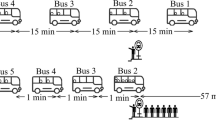Abstract
Nowadays, traffic jam becomes a big problem for cities with large population. Bus is a main component of public transportation, and then the design of bus stop position and size should improve efficiency of public transportation. This research focuses on a certain bus stop between two intersections. The target of this research is to work out a best plan for the bus stop type, position and size. To solve the problem of bus stop setting, a mixed traffic flow model including buses, cars and trucks is established by CA (cellular automaton) model. And then the best bus stop settings plans can be determined through the simulation with a traffic simulator.







Similar content being viewed by others
Explore related subjects
Discover the latest articles, news and stories from top researchers in related subjects.References
Zhao X, Gao Z, Li K (2008) The capacity of two neighbor intersections considering the influence of the bus stop. Physica A 387(18):4649–4656
JIA B, LI XG, Jiang R (2009) The influence of bus stop on the dynamics of traffic flow. Acta Phys Sin 58(10):6845–6851
Yu-Kun S, Xiao-Mei Z (2009) Combined bottleneck effect of on-ramp and bus stop in a cellular automaton model. Chin Phys B 18(12):5242
Gu W, Cassidy MJ, Li Y (2014) Models of bus queuing at curbside stops. Transport Sci 49(2):204–212
Nagel K, Schreckenberg M (1992) A cellular automaton model for freeway traffic. J Phys I (France) 2:2221–2229
Biham O, Middleton AA, Levine DA (1992) Self-origination and a dynamical transition in traffic flow models. Phys Rev A 46:6124–6127
Acknowledgements
This work was supported by “National Natural Science Foundation of China (Grant No. 71461026)” and “12th Five Year Plan of Jilin Provincial Department of Education (2015)”.
Author information
Authors and Affiliations
Corresponding author
About this article
Cite this article
Cui, C., Quan, J. Bus stop setting problem based on cellular automaton traffic model. Artif Life Robotics 24, 135–139 (2019). https://doi.org/10.1007/s10015-018-0470-x
Received:
Accepted:
Published:
Issue Date:
DOI: https://doi.org/10.1007/s10015-018-0470-x




